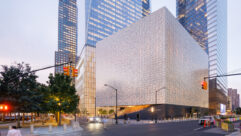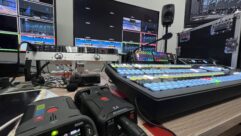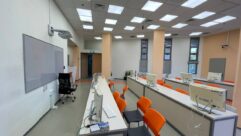
New AV System for New World Center, Part 2
Jun 2, 2011 1:38 PM,
with Bennett Liles
Listen to the Podcasts
|
Editor’s note: For your convenience, this transcription of the podcast includes timestamps. If you are listening to the podcast and reading its accompanying transcription, you can use the timestamps to jump to any part of the audio podcast by simply dragging the slider on the podcast to the time indicated in the transcription.
Miami’s New World Center is the performing home to some of the best young musicians anywhere, and the performance hall was designed to completely immerse visitors in sight and sound. Brad Gallagher, managing engineer for Pro Sound and Video is going to tell us how this massive AV project came together, next up on the SVC podcast.
Brad, thanks for being back with me from Pro Sound and Video for the New World Symphony installation down there in Miami. You did not only some great things inside the venue but the things you did outside the building are truly fantastic. There’s a projection wall out there that you could probably see from a cruising plane. Tell me something about that six-story projection wall and how you came up with that.
Yeah, this was a really interesting project on the outside of the facility. So we had already had some experience with the 30k’s inside and about halfway through the project, when we got to the outside of the building, they had upgraded those and come out with 35k’s. So on the inside of the building we’ve actually got 16 30k’s but in the tower we’ve got four of the 35k’s and the image out there is…it’s a six-story building, I want to say the final image is maybe 100ft. wide by about 70ft. tall. We’ve got a couple of different aspect ratios that we’ve got setup as special screens. It’s a custom aspect that we’re doing for the wall coverage—give them a lower crawl and that sort of thing—and then we’ve got a 69 Aspect that covers the top and they use that for doing reproduction of the symphony through their switching system whenever we’re using the D-Mitri system to reproduce the symphony outside as well as when they’re playing Blu-ray discs through the park which is something that they’ve just recently started. The city’s doing this in collaboration with the symphony and I think it’s once a week they’re coming out there and playing a movie and the response that I’ve seen from people is just fantastic—the entire garden area out there, they have been filling it with seating pretty much front to back you can barely step through the thing when they have events out there. [Timestamp: 2:34]
Now how far away from the wall is the projection tower?
The projection tower is, I would say, it’s somewhere between 220 to 240ft. back. [Timestamp: 2:42]
OK—mighty big throw, of course you’ve got to protect the projectors up there. Are there any operators up there or is it all remoted? How do they do that?
No it is remoted. We’ll get up there for maintenance, but predominantly everything’s run from the ground. We’ve got touch panels and then everything’s available through Ethernet interface but the real trick for that was getting everything to fit in the tower. Everything’s always an aesthetic compromise for fit and function and in this case those projectors being about 30,000 BTU per hour. We ended up having about 120 BTU per hour in this little sardine can along with your all of your other panels that we had up in there, there were dimmer racks, and it’s just really, really jammed together and then when you think of it, you’ve also got to have enough space to get these things in and out of the tower. We have a chain motor to get the stuff up and down to the ground. It was extremely tight just like the inside of the building. We ended up modeling everything in 3D and it was pretty much down to the inch in the tower as well as inside the building. [Timestamp: 3:49]
You can certainly see that from a long way off. The building would grab your attention when you have that projection going on out there, but not only is it impressive as far as sight and lighting and so forth but you’ve got something like 158-speaker audio system out there too?
Yeah that was a whole lot of fun to put together. As far as I’m aware, I don’t think anything’s ever been done on this scale and we’ve just gotten an amazing input from people on this. So what we’ve got outside is we’ve got a Meyer Constellation system that’s run through a D-Mitri processor and we’ve got somewhere in the order of, I want to say, it’s about 150-160 discrete speakers out there. So we’ve got two 3 and then 2 MSL-4’s across the front that are doing a LCR system and then they’re reinforced for the throw that we’ve got with two towers of Melody Hangs, we’ve got 6-700 HP’s in that front planter and then another four 600’s in the towers along with the Melody Hangs. Then coming back through what we’ve been calling as ballet bars, it’s a tubular structure that goes back for a little over, maybe 150ft. and the bar is about 20ft. high and we’ve got speakers, Melody UPGA, going pretty much every inch that you could fit a speaker into this pipe, we’ve got a speaker. And we’re taking a microphone mix from about 16 mics that are just picking up ambient sounds from the hall and then also mixing that with around 24 discrete microphones that are placed on stage and the concept is to recreate the sound of the hall outside in this prime listening area of park outside which is the Miami Soundscape. [Timestamp: 5:38]
Well that’s a really tall task to make it sound outside, in a totally different environment, like it does inside, and that’s why they went with using the Constellation.
Yeah and like I said the feedback that we’ve just gotten on this thing is incredible. We’ve had people tell us that the biggest complication that they’re having now is determining where the prime place to be for events is—on the inside or on the outside—and for what’s going on in there, we consider that paying a huge compliment to the system. [Timestamp: 6:08]
And that’s a big area. That’s what, a two-and-a-half-acre park out there?
Yeah, we’ve got a prime listening area that’s…if you just look down on it from above, it’s probably about a little over a third of the land that they’ve got on that but yeah, it’s just a huge area to be covering and the system just does a great job of recreating that. Now they’ve also started, I mentioned to you a little bit before, doing the Blu-ray events so in addition we’ve also got essentially a giant movie theatre out there that the guys from Meyer came and spent several days programming both for the Constellation setup that’s recreating the inside of the hall as well as the cinema system out there, and so now they’re playing movies once a week and doing some really cool stuff with that. The very first night that they went out there they played Avatar and the response has just been fantastic. People just love really going out there in a field and having this giant area with an enormous screen like that and it’s been a fantastic response. [Timestamp: 7:08]
New AV System for New World Center, Part 2
Jun 2, 2011 1:38 PM,
with Bennett Liles
And you’ve got the Meyer D-Mitri system pulling all that together. What was it like setting all that up?
Well the system’s incredibly complicated, but we were really fortunate to have the guys from Meyer out there. I think at some point we probably had four or five people we were rotating through a crew of…I think in total, we may have had seven of their guys out there. They were just tremendously valuable in supporting this project and getting us through it. When you have this much technology and the sort of timelines that we were pulling through for this project—backup is just essential and they really came through on that. [Timestamp: 7:44]
Yeah, speaking of the timeline, how long did the whole installation take from beginning to end on this?
It was really tight. I want to say that the prime portion of our work we probably pulled out in…I want to say about two, two and a half months. Which when you think about the amount of speakers, I mentioned we’ve got like 150-160 speakers, it’s still just leaves me sort of scratching my head as far as how we managed to get all that stuff in there and get everything up and running but we’ve just got some great guys. [Timestamp: 8:14]
So what turned into the, I guess you’d say, the biggest challenge on this project? Was it the timeline or the architecture or were there other things at work?
Yeah I think just pulling everything together—and we’re very fortunate that we just have the engineering and the project management resources and the manufactures support to pull off something of this large of a scale—just getting everything in that short of a time period and getting everything coordinated when you have, like I said, those mechanical spaces that are changing size on a daily basis it takes a lot to stay on top of it. [Timestamp: 8:48]
And of course when they do one of these shows, now that it’s in operation, who’s running the audio stuff—the console, the mixing and the lighting, is that an all in-house crew?
They’re handling all that in-house. [Timestamp: 8:59]
And I guess you had to provide some training on this whole system, so when did you work the in-house people into it?
Between the three scopes of work that we had out there that had training associated with them—which is the video projection, the audio recording, and the audio reinforcement system—we had 120 hours of training, which is just an enormous amount of training. And so what we did is we worked really closely with all of the people in the facility and, working with their staff, we set up a timeline that probably got them going two months before the project came to a close so that they could come up to speed. 120 hours of training is just really intense and the amount of technology that they’re coming into—we’ve got all these Coolux media serves, the enormous D-Mitri system, and then several other manufacturers that…several of these systems were beta because at the time that we came into the facility one of their directives was to get the newest, the latest, and the greatest so as we went through we were coming out with systems that a lot of them didn’t even get past a beta sort of platform until we were commissioning this system. [Timestamp: 10:07]
Yeah, I guess on a lot of this stuff you were kind of writing the book as you went.
Yeah and it’s great to be in a position where we have these relationships with manufacturers that we can get in there and get them newer stuff that’s out there and have people that will work with us that we can rely on when we’re having those sort of issues and going through a facility that’s as complex as this one. [Timestamp: 10:27]
Well, when they had the first show in the building, what was that like? Were you there for the tech system debut on this?
Yeah we were there to support them all week long. We had several people on staff and it’s just fantastic—we were working on this for 18 months and it’s just great to see something like this come together and see so many people get so much enjoyment out of a facility like this. It’s really something unique and incredible. [Timestamp: 10:54]
All right, well it’s certainly done on a grand scale. That alone just knocks me over with all the things you had to pull together for this and it sounds like you did a first rate job on it. Brad Gallagher from Pro Sound and Video in Miami and the New World Symphony. Thanks for giving us the backstage installation details on it.










